
OAXACA
The drive south from Puebla to Oaxaca is three-quarters uninteresting. But the section up and over the mountains is quite beautiful. As we climb out of the Tehuacán-Cuicatlán Valley, we’re surrounded by striking columnar cactus forests. Climbing into the Sierra Madre de Oaxaca, the vegetation changes to pine oak/forests, and there are deep cleft canyons, flat-topped buttes and uplift red rock cliffs that loudly shout faultline! Very reminiscent of the southern Colorado area around Mesa Verde.
 It’s been two to three decades since we visited Oaxaca, and are excited to become reacquainted, as we remember little. Then we stayed at a fancy hotel, but this trip have rented a quirky three-level apartment, built into an old disused brick aqueduct a half dozen blocks north of the Zocalo. The three floors contain an eclectic mix of furniture, objets, art and plants. The kitchen is minuscule, but functional. The apartment is set in a slightly hilly working-class neighborhood of colorful one and two-story buildings lining cobbled streets. Nearby stores are locally oriented: corner baker; coffee shop; tortilleria; barber; small organic grocer; pastelleria and ubiquitous corner bodeguitas.
It’s been two to three decades since we visited Oaxaca, and are excited to become reacquainted, as we remember little. Then we stayed at a fancy hotel, but this trip have rented a quirky three-level apartment, built into an old disused brick aqueduct a half dozen blocks north of the Zocalo. The three floors contain an eclectic mix of furniture, objets, art and plants. The kitchen is minuscule, but functional. The apartment is set in a slightly hilly working-class neighborhood of colorful one and two-story buildings lining cobbled streets. Nearby stores are locally oriented: corner baker; coffee shop; tortilleria; barber; small organic grocer; pastelleria and ubiquitous corner bodeguitas.
A UNESCO World Heritage Site, Oaxaca is a manageable gem of a colonial town, at around 300,000 people, versus Puebla’s three million. Cobbled streets rise and fall over gentle hills, lined with bright colorful houses and through public squares, ranging from the tiny plazuelita of la Cruz de Piedra a block from our flat, to the forested main zocalo downtown. The plaza filled with spiky agaves in front of the Santo Domingo church is a lively gathering space, holiday lit, surrounded by artisan stalls and filled with locals enjoying the festive season.
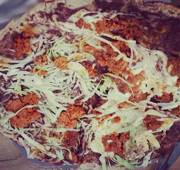 There are lots of simple, small local restaurants, and after basic kitchen provisioning, we head down Rufino Tamayo a couple blocks to La Casa del Tío Güero and take a small table just steps in from the open doors. The menu is all local specialties, with lots of mole choices. We order a tlayuda quesilla—an 18-inch corn tortilla griddled crisp on a comal, topped with stringy queso oaxaceno and beans, folded over, and served with quacamole, salsa and hot chiles. Enchiladas de pollo mole negro are delicious, dark and mysterious, but a bit on the sweet side for our taste.
There are lots of simple, small local restaurants, and after basic kitchen provisioning, we head down Rufino Tamayo a couple blocks to La Casa del Tío Güero and take a small table just steps in from the open doors. The menu is all local specialties, with lots of mole choices. We order a tlayuda quesilla—an 18-inch corn tortilla griddled crisp on a comal, topped with stringy queso oaxaceno and beans, folded over, and served with quacamole, salsa and hot chiles. Enchiladas de pollo mole negro are delicious, dark and mysterious, but a bit on the sweet side for our taste.
 On a bright late December morning we head south toward the centro and soon encounter a two-block Christmas market on Macedonia Alcala. Small vendors display textiles, clothes, shawls, rugs, handicrafts, jewelry, the iconic black Oaxaca pottery barro negro, deep green ceramics from Santa María Atzompa, and the local famous colorfully imaginative carved wooden alebrijes. The market seems government promoted, with most stalls displaying a uniform sign designating the area village from whence the goods come. The market opens on to the plaza in front of the Templo de Santo Domingo, filled with a gridwork garden of blue-green agave.
On a bright late December morning we head south toward the centro and soon encounter a two-block Christmas market on Macedonia Alcala. Small vendors display textiles, clothes, shawls, rugs, handicrafts, jewelry, the iconic black Oaxaca pottery barro negro, deep green ceramics from Santa María Atzompa, and the local famous colorfully imaginative carved wooden alebrijes. The market seems government promoted, with most stalls displaying a uniform sign designating the area village from whence the goods come. The market opens on to the plaza in front of the Templo de Santo Domingo, filled with a gridwork garden of blue-green agave.
Built in 1555, the twin towered Templo de Santo Domingo church and attached convent are another fine  example of Mexican baroque architecture. The church’s interior is elaborate, dripping with gold, embellished with carved stone and woodwork and decorated with colorful paintings. The arched ceiling is spectacularly ornamented and dotted with medallions featuring catholic martyrs. Above the entrance the ceiling shows a vine from whose golden tendrils emerge 34 portraits depicting the family tree of St. Domingo de Guzmán, the founder of the Dominican order. The complex includes a convent (white habit-clad nuns have a table selling Roscones for Rayus Magus), library and the Museum of Oaxacan Cultures, which exhibits some of the most important finds — gold jewelry, masks, statues and
example of Mexican baroque architecture. The church’s interior is elaborate, dripping with gold, embellished with carved stone and woodwork and decorated with colorful paintings. The arched ceiling is spectacularly ornamented and dotted with medallions featuring catholic martyrs. Above the entrance the ceiling shows a vine from whose golden tendrils emerge 34 portraits depicting the family tree of St. Domingo de Guzmán, the founder of the Dominican order. The complex includes a convent (white habit-clad nuns have a table selling Roscones for Rayus Magus), library and the Museum of Oaxacan Cultures, which exhibits some of the most important finds — gold jewelry, masks, statues and 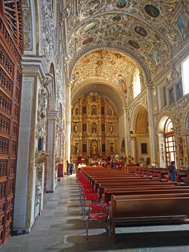 ceramics — discovered at Monte Alban, the pre-Colombian ruins near town. Just east of the Templo is a botanic garden—precisely an ethnobotanic garden, filled with wild native plants such as agaves, cactus, cycads, balsa and ceiba trees, and spice plants such as achiote and vanilla. It’s a very different, almost alien garden, with spiky, feathery, thorny and fuzzy forms. Rows of tall columnar organ-pipe cactus—such as we saw coming over the mountains—fronting the mirror pool may be the gardens most standout
ceramics — discovered at Monte Alban, the pre-Colombian ruins near town. Just east of the Templo is a botanic garden—precisely an ethnobotanic garden, filled with wild native plants such as agaves, cactus, cycads, balsa and ceiba trees, and spice plants such as achiote and vanilla. It’s a very different, almost alien garden, with spiky, feathery, thorny and fuzzy forms. Rows of tall columnar organ-pipe cactus—such as we saw coming over the mountains—fronting the mirror pool may be the gardens most standout  feature.
feature.
In the people packed plaza, vendors of street snacks include elote—charred ears of corn slathered with crema and dusted with chile, tacos and sopes, quesadilla griddles, memelas—slightly thicker rounds of griddled masa topped with beans and queso fresco, and even a crepe iron affixed to the front of an ancient motorcycle whose tender creates rolled treats filled with caramel and banana. An interesting and new to us specialty is Tejate—a drink  created by mixing water with a ground-up paste of cacao beans, toasted maize flour, mamey fruit pits, and flor de cacao. The drink, typically served in gourd halves, is a beige brown, slightly chalky liquid tasting like a combination of coffee and chocolate milk, with a frothy white layer on top...this part is the cacao fat and has a buttery mouthfeel. Tejate dates back to the Zapotec and Mixtec peoples in pre-Hispanic Mexico.
created by mixing water with a ground-up paste of cacao beans, toasted maize flour, mamey fruit pits, and flor de cacao. The drink, typically served in gourd halves, is a beige brown, slightly chalky liquid tasting like a combination of coffee and chocolate milk, with a frothy white layer on top...this part is the cacao fat and has a buttery mouthfeel. Tejate dates back to the Zapotec and Mixtec peoples in pre-Hispanic Mexico.
Across the plaza, the Instituto de Artes Gráficas de Oaxaca has several beautiful rooms of books on art arranged around an interior patio. There is currently an exhibition of many important Mexican graffic artists, the top of the historic list being Rufino Tamayo, and the most notable current artist, Francisco Toledo. There is a wide range of style, technique and subject matter, but the common thread seems to run to the dark, troubled and dismal, as opposed to the bright and uplifting.
artist, Francisco Toledo. There is a wide range of style, technique and subject matter, but the common thread seems to run to the dark, troubled and dismal, as opposed to the bright and uplifting.
The streets of Oaxaca have a very different feel than Puebla. Architecture is simpler, less elaborate and without all the intricate tile ornamentation. We nip into the luxury hotel Quinta Real, set in an old convent, for a look around the three  courtyards and public areas—very colonial in feel—and very pricey, at $600 a night for basic room. There is a tranquil courtyard restaurant, to which we will return another day, and lovely folk art and sculptures on display in the lobby, including some of the most incredible alebrijes set in glass cases—an owl-faced serpent, monkey-headed fox and a snail with wings.
courtyards and public areas—very colonial in feel—and very pricey, at $600 a night for basic room. There is a tranquil courtyard restaurant, to which we will return another day, and lovely folk art and sculptures on display in the lobby, including some of the most incredible alebrijes set in glass cases—an owl-faced serpent, monkey-headed fox and a snail with wings.
Nearby, two collectives offer folk art and handcrafts: MARO: Mujeres Artesanias de las Regionas de Oaxaca sells work made exclusively by women crafters. Two blocks away, La Casa de las Artesanias has a larger selection, created by both men and women....quality seems equivalent in both. One block south and east in an 18th century edifice MACO has permanent and rotating exhibitions of contemporary Mexican art. During our visit an exhibition titled XVIII Rufino Tamayo Bienniele shows 48 of the famous artist's works.
 We only had planned one must-do restaurant in Oaxaca, and as our 1:30 reservation approaches, we flag a cab and bounce a dozen and a half blocks to Criollo, famous Mexican chef Enrique Olvera’s collaboration with local chef Luis Arellano to partake of a leisurely 3-hour, 7 course tasting menu. On the meandering post-lunch way back to nuestra casa, we find an amazing bakery nearby, Pan con Madre, where they create incredible breads, scones, focaccia, quiches and more. We latch on to a still warm pan integrale with sesame seeds to make our late, light simple supper of avocado toast. And margaritas, of course.
We only had planned one must-do restaurant in Oaxaca, and as our 1:30 reservation approaches, we flag a cab and bounce a dozen and a half blocks to Criollo, famous Mexican chef Enrique Olvera’s collaboration with local chef Luis Arellano to partake of a leisurely 3-hour, 7 course tasting menu. On the meandering post-lunch way back to nuestra casa, we find an amazing bakery nearby, Pan con Madre, where they create incredible breads, scones, focaccia, quiches and more. We latch on to a still warm pan integrale with sesame seeds to make our late, light simple supper of avocado toast. And margaritas, of course.
 Saturday morning, we hike down the main pedestrian street, Alcala, to the corner of the Zócalo to meet a guide, Alberto Lopez who we’ve hired for the day to show us some of the nearby artisanal villages. It turns out that he has his current wife, Claudia, and his 14 year old daughter Tanya in tow.....it’s Tanya's introduction to the business. We head southeast for 20 minutes or so, through several villages, and stop in San Bartolo Coyotepec....how about those Zapotec names.....where the famous black Oaxaca pottery—barro negro—is made...and only here. Nearby are the mines that produce the unique clay that makes this pottery, and by decree, only male artisans from this village can mine the clay.
Saturday morning, we hike down the main pedestrian street, Alcala, to the corner of the Zócalo to meet a guide, Alberto Lopez who we’ve hired for the day to show us some of the nearby artisanal villages. It turns out that he has his current wife, Claudia, and his 14 year old daughter Tanya in tow.....it’s Tanya's introduction to the business. We head southeast for 20 minutes or so, through several villages, and stop in San Bartolo Coyotepec....how about those Zapotec names.....where the famous black Oaxaca pottery—barro negro—is made...and only here. Nearby are the mines that produce the unique clay that makes this pottery, and by decree, only male artisans from this village can mine the clay. 
We arrive at the very primitive workshop, or alfareria, of Lorenzo Mateo, and spend a half hour learning about the process, watching Lorenzo create a jarra by hand on a Zapotec wheel, which consists of two shallow plates set on the floor stacked curved sides against each other. A true master at work and fascinating to see. Nearby his wife elaborately decorates an enormous cántaro—a type of container used for storing liquids. Behind the studio, Lorenzo show us the underground kiln he heats with cerrito wood and in which he fires pieces for up to ten hours. There is a small rustic shop in front, with lovely pieces on display—the incongruous juxtaposition of the prices....low...and amount of time and  labor....high....that go into each piece is remarkable.
labor....high....that go into each piece is remarkable.
Three blocks away, the much larger facility of the five families who are successors to Doña Rosa has a much broader stock, but no finer quality. Doña Rosa’s claim to fame is that in the mid 1950’s she discovered the process of polishing the unfired leather-ware pots with quartz stones before firing, to obtain a silken glossy finish, rather than the matte black that was previously possible. Here we also learn that the length of firing determines whether a jug or vase is waterproof—that takes much longer—and that closed, sealed firing will create the expected deep black pottery, but that open firing will result in a lovely leather brown color.
There is an artisan market of dozens of small stalls, each representing one potter, and we stop because we have not yet found the specific gift we want for a friend. We peer into the dark stall interiors of each, and as luck sometimes dictates, only at the very last stall do we find what we seek, a simple but elegant pitcher.
 One of Oaxaca’s other most famous handicrafts are the colorful, whimsical, phantasmagorical carved and painted wooden figures called alebrijes. A few kilometers down the road we come to the village of San Martín Tilcajete, one of two villages where they are created, and the workshops of Jacobo and Maria Angeles. Entering through the gate in a deep blue wall we arrive at a plant filled courtyard and are introduced to Rogelio, a Los Angeles transplant and friend of the family who will show us soup to nuts. This has become a large enterprise, employing many dozens of villagers, and includes an apprenticeship program for teenagers to learn to become craftsmen. All of the work areas are covered by a roof, but open to the central court. At the far end is the carving area, where craftsmen take machetes, knives and chisels to the copal logs.
One of Oaxaca’s other most famous handicrafts are the colorful, whimsical, phantasmagorical carved and painted wooden figures called alebrijes. A few kilometers down the road we come to the village of San Martín Tilcajete, one of two villages where they are created, and the workshops of Jacobo and Maria Angeles. Entering through the gate in a deep blue wall we arrive at a plant filled courtyard and are introduced to Rogelio, a Los Angeles transplant and friend of the family who will show us soup to nuts. This has become a large enterprise, employing many dozens of villagers, and includes an apprenticeship program for teenagers to learn to become craftsmen. All of the work areas are covered by a roof, but open to the central court. At the far end is the carving area, where craftsmen take machetes, knives and chisels to the copal logs.  Adjacent is the apprentice classroom, and next to the school area is an open kitchen in which half a dozen women are preparing lunch for the entire staff.
Adjacent is the apprentice classroom, and next to the school area is an open kitchen in which half a dozen women are preparing lunch for the entire staff.
In San Martin, the style follows the Zapotec mythology of spirit animals. The Zapotec calendar has 13 months of 20 days. Each birth year has a specific spirit animal, a tona and each combination of birth date and month has a protective animal, a nahual.
The figures are carved from copal wood, a tree which grows in a very twisted and curvy fashion. On land the Angeles own in the nearby hills, around 2,000 new trees are planted each year, and those grow for 20-25 years before harvesting. The trees are cut whole, stripped of bark, and allowed to dry thoroughly. Like Michelangelo and his blocks of marble, the alebrijes carvers “find” the animal in the twists and kinks of the wood, and “release” it. Once carved,  the figure is dried and sanded and passed to the painting workshop.
the figure is dried and sanded and passed to the painting workshop.
Jacobo and Maria are the uber-masters, and they have a dedicated team hand-picked from all the carvers. There appear to be at least a dozen other masters, and with tiny brushes and vibrant pigments made from cochineal, indigo, limestone, zinc, and other natural elements, they are intricately painting jaguars, iguanas, monkeys, owls, coyotes, and eagles. They also create combination animals to match the spirit duos of customers who place custom orders, such as snake with an owl face, or a coyote with eagle wings. Depending on size, a single figure can take from a month to a half-year to paint. The detail is amazing, and they are simply gorgeous. Each animal in the mythology has a set of characteristics—the coyote connotes watchful observation, the turtle always a troublemaker breaking rules, and the eagle embodies technical and strategic power. Monkey is crafty and a rule breaker, iguana is intelligent and likes to learn. Roger asks our date information, and consulting an astrologica zapoteca, finds that Troy is an iguana with monkey, and that I am deer with turtle. Do we wish to order a custom figure combining all four? We see one such being finished by one artist.
In the gallery, we select several small rabbits as gifts for friends, and from the special collection of Jacobo and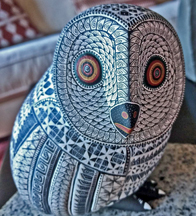 Maria, an exquisite small owl in blue black and white, with amber eyes. As we approach the cashier, Roger introduces us to Jacobo, outgoing and friendly who, on learning we are from Sonoma, tells us that he had an exhibition at a gallery on the Plaza a dozen years or so ago. He also has pieces in the Smithsonian, and has met the Pope, who commissioned a special figure.
Maria, an exquisite small owl in blue black and white, with amber eyes. As we approach the cashier, Roger introduces us to Jacobo, outgoing and friendly who, on learning we are from Sonoma, tells us that he had an exhibition at a gallery on the Plaza a dozen years or so ago. He also has pieces in the Smithsonian, and has met the Pope, who commissioned a special figure.
Sunday morning, we have signed up for a walking tour led by a young woman guide named Franny. We meet downtown, and zig-zag our way around town, first visiting the
 Aqueduct de Xochimilco near our apartment and are shown what’s called a water box—literally a fountain where the aqueduct’s water was available for collection by local women to lug home. The cultural museum, located in monastic cloisters adjoining the Santa Domingo church, at the center of which is a beautiful fountain, houses a hoard of Mixtec treasures from Tomb 7 at Monte Albán.
Aqueduct de Xochimilco near our apartment and are shown what’s called a water box—literally a fountain where the aqueduct’s water was available for collection by local women to lug home. The cultural museum, located in monastic cloisters adjoining the Santa Domingo church, at the center of which is a beautiful fountain, houses a hoard of Mixtec treasures from Tomb 7 at Monte Albán.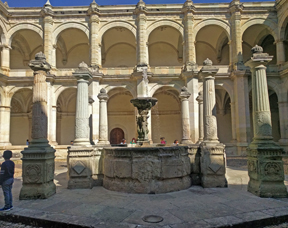 We wander downtown to the Cathedral, which dates to 1535 but whose front is 18th century baroque—there have been plenty of earthquakes, and resultant re-building. We continue through the leafy Zocalo to the Mercado Benito Juárez, packed with stalls of fruits and vegetables of all types and colors. Across the alley is the San Juan de Dios market, filled with counters and small restaurant spaces serving everything from menudo to pig’s ear.
We wander downtown to the Cathedral, which dates to 1535 but whose front is 18th century baroque—there have been plenty of earthquakes, and resultant re-building. We continue through the leafy Zocalo to the Mercado Benito Juárez, packed with stalls of fruits and vegetables of all types and colors. Across the alley is the San Juan de Dios market, filled with counters and small restaurant spaces serving everything from menudo to pig’s ear. 
Finishing the tour, we cross the Zocalo again just as the Sunday noon orchestra concert, begins, with the conductor announcing that today’s piece will be a paso doble by Spanish composer Vicente Ruiz.
We head to the Quinta Real and Los Naranjos garden restaurant to relax with a margarita, and then share Memelitas de lengua de res—tender beef tongue with black beans and pickled red onion, and Tacos de barbacoa—filled with shredded lamb, salsa, white onion, cilantro and lime.
After a nap and some reading downtime, we head back toward the centro and our dinner reservation at El Destilado, a sought-after new restaurant started by three young gringos who were enamored of Oaxaca. Two of the founders have since moved on, and the new chef is a young woman, Valerie Frei. The tasting menu starts with the coctel del dia, which today is a mezcal negroni, with mezcal replacing the gin—a great twist which adds the smoke of the mezcal. What follows is 9 courses of creativity, whimsy and deliciousness. Standout dishes include tiny blue corn gorditas topped with cheese and finely  chopped and herbed roast squash; a small square of grilled Mahi-mahi atop a deeply-flavored soy and shrimp-shell jus, accompanied by one perfectly grilled shrimp on a swipe of sesame mole; tiny green and brown paletas—frozen popsicles of purée of zapote negro, a type of persimmon, and the herb rue, sprinkled with citrus salt—sweet, sharp and salty all at once. Desserts are purple corn pudding topped with strawberry marmalade and hawthorn fruit, and panna cotta with roasted banana, pear poached in vanilla with a drizzle of pechuga mezcal.
chopped and herbed roast squash; a small square of grilled Mahi-mahi atop a deeply-flavored soy and shrimp-shell jus, accompanied by one perfectly grilled shrimp on a swipe of sesame mole; tiny green and brown paletas—frozen popsicles of purée of zapote negro, a type of persimmon, and the herb rue, sprinkled with citrus salt—sweet, sharp and salty all at once. Desserts are purple corn pudding topped with strawberry marmalade and hawthorn fruit, and panna cotta with roasted banana, pear poached in vanilla with a drizzle of pechuga mezcal.
The next evening, New Year’s Eve, we wander a few blocks across the plazuelita from our apartment and find two stools at La Mezcalerita—preparations are underway for a big NYE blowout celebration on the roof terrace. The bar again has an extensive mezcal list, and we proceed to conduct an informal mezcal tasting to start the celebrations. An hour later, we return to the apartment, and the crack and boom of fireworks have already started—they will go until almost four in the morning. We have a small bottle of mezcal tobala that we acquired from our local guide, Alberto,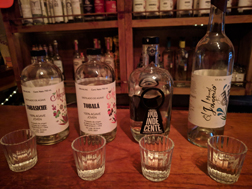 who with his wife Claudia, are trying to establish a market for it under the brand Chosa Nostra—we’ll have a toast to the new year at midnight, or however late we make it……..
who with his wife Claudia, are trying to establish a market for it under the brand Chosa Nostra—we’ll have a toast to the new year at midnight, or however late we make it……..